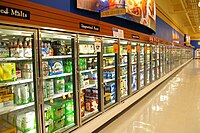
Photo from wikipedia
For the use in packer elements for oil exploration, rubber materials are required that can withstand high mechanical loads, high temperatures, and aggressive chemical media. To fulfill these demands, we… Click to show full abstract
For the use in packer elements for oil exploration, rubber materials are required that can withstand high mechanical loads, high temperatures, and aggressive chemical media. To fulfill these demands, we designed composites of hydrogenated acrylonitrile butadiene rubber filled with both carbon black and short cut aramid fibers. Scanning electron micrographs indicate a strong connection between the resorcinol formaldehyde latex fiber coating and the peroxide-cured rubber matrix. During the preparation of the test specimens, especially care was taken to obtain samples with very well-defined fiber orientations. We studied the effect of fiber anisotropy on the hardness and on the mechanical properties under uniaxial elongation and cyclic compression at room temperature and 150°C. The strongest reinforcing effect is observed when the fibers are oriented along the main direction of deformation. For tensile test, this is the case, as expected, for fibers oriented parallel to elongation. For compression tests on cylindrical specimens, we find that the fiber orientation perpendicular to compression direction is most effective. At 20–40% strain, tensile tests exhibit a pronounced yield stress which is likely the result of the loss of adhesion between the rubber matrix and the fibers. Repeated loading and unloading compression tests reveal a considerable stress softening effect between the first and second cycle for fiber-filled composites. At 150°C, the rubber composites soften considerably, but small amounts of fiber still induce a significant reinforcement. POLYM. COMPOS., 2017. © 2017 Society of Plastics Engineers
Journal Title: Polymer Composites
Year Published: 2018
Link to full text (if available)
Share on Social Media: Sign Up to like & get
recommendations!